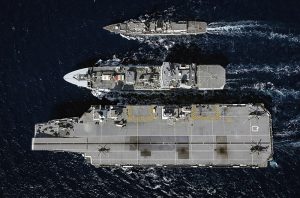On July 1, 1997, the government of Her Majesty Queen Elizabeth II handed over its colony of Hong Kong to sovereign Chinese control. Twenty-four years later, the similarly-named aircraft carrier, HMS Queen Elizabeth, has arrived in Asia – this time not to hand over a piece of its former empire, but to make a statement of Britain’s intent to support the countries and territories of Southeast Asia, and the world’s shipping, from increasing Chinese aggression, under the U.S.-championed slogan of the free and open Indo-Pacific (FOIP).
HMS Queen Elizabeth is “the largest vessel ever built for the Royal Navy” and can carry up to 40 aircraft. Leading a flotilla into the South China Sea on July 26, it has been engaging in naval exercises throughout its journey since setting sail from Portsmouth in the United Kingdom on May 22.
The mission of HMS Queen Elizabeth in her maiden deployment is not solely focused on showing strength to China. As the flagship of Carrier Strike Group 21 (CSG21), the task group will have visited “40 nations including India, Japan, Republic of Korea and Singapore in a deployment covering 26,000 nautical miles” by the time its seven-month journey is over.
But the very fact that 40 nations will have come out to welcome the British carrier, with many of them participating in joint military exercises as well, is a projection of power and continuing influence from Western nations that is not lost on China. Countries such as India and Singapore have also conducted joint naval exercises with China, but given that they are regional neighbors of China, the need for such cooperation is common sense.
But Britain’s naval foray back into Asia isn’t stopping at a sail around the Indian Ocean and the South China Sea. After its visit to Japan in September, Britain will permanently deploy two warships in Asian waters.
As The Diplomat’s Steven Stashwick noted, “It is not clear what type of ships the Royal Navy will keep in the region or what the permanent deployment’s basing arrangements will be, but will appear to include offshore patrol vessels (OPV) supported by bases in Australia and Singapore.”
China’s response, in both tone and substance, has been predictable.
The Global Times, an English-language publication owned by the Chinese Communist Party, published an opinion piece describing the move as Britain’s attempt to still live “in colonial days.”
The structure of the article is familiar to any China watcher: First, belittle the offending target, then threaten them.
The article says that the U.K.’s motive is “obvious,” and goes on to say that Britain “wants to provoke China, engage in the so-called freedom of navigation like the US does and demonstrate its military presence in the Asia-Pacific region.”
However, Britain can’t face “its own decline,” and is “still living in the ‘auld lang syne.’”
The U.K. should worry, Global Times opines, that “China will make it clear to the US that London will be punished by acting like Washington’s running dog in provoking Beijing.”
This is something that hostage takers and extortionists say. And yet, this is the language approved by the Chinese Communist Party and employed internationally by its spokespeople.
It is also interesting that the author suggests that Britain’s passage through the South China Sea, and its planned permanent deployment of two warships, is “provoking” to Beijing. Why would it be, under normal circumstances? The use of the word is in itself provocative, as it signals that at least part of Britain’s unspoken mission – to get under the skin of the Chinese government – has worked.
Wu Shicun, president of China’s National Institute for South China Sea Studies, in an article commenting on the ship’s arrival, pulled no punches.
The South China Morning Post reports that Wu said, “If the ship entered within 12 nautical miles of Chinese-controlled islands, Beijing ‘must conduct countermeasures to let them pay the price, and prevent other countries from doing the same in the South China Sea.’”
Of course, it is to be expected that international naval and maritime movements will continue to test even that 12-nautical mile line, which denotes the legal limit of a maritime feature’s territorial sea under international law. An international arbitral tribunal has already rejected China’s claims to control over the vast majority of the South China Sea, and even ruled that none of the features in question are capable of generating a territorial sea at all, regardless of who claims them. In a 2016 ruling that firmly denied China’s assertions of historical rights in a waterway in which many other nations also have claims, the tribunal sided with the Philippines, which had brought the case. The tribunal also made a declaration that China is obliged to comply with UNCLOS (the United Nations Convention on the Law of the Sea) and that the award is legally binding on China.
Britain’s naval response to China’s escalating disdain for international norms is a reassuring and welcome move to most Asian countries. To China – the one nation that feels threatened by Britain’s move – it should be a catalyst that invites impartial analysis of its own behavior, if not actual introspection. Neither is likely.
A previous version of this article implied the HMS Queen Elizabeth was named after the current British monarch; it was named for Queen Elizabeth I, not Queen Elizabeth II.
































